Endangered species represent a critical aspect of biodiversity, playing essential roles in ecosystems worldwide. However, factors like habitat destruction, climate change, pollution, and poaching have led to alarming rates of species extinction.
Conservation efforts are initiatives aimed at preventing this loss by addressing threats and promoting the recovery of vulnerable species. This article explores the role of conservation efforts in saving endangered species, delving into methods, success stories, and ongoing challenges.
Endangered Species
Endangered species are animals, plants, or other organisms at risk of extinction. The International Union for Conservation of Nature (IUCN) Red List categorizes species based on their conservation status. These categories range from “Least Concern” to “Extinct,” with endangered species falling under “Critically Endangered,” “Endangered,” or “Vulnerable.”
| Category | Description |
|---|---|
| Critically Endangered | Extremely high risk of extinction in the wild |
| Endangered | High risk of extinction in the wild |
| Vulnerable | High risk of endangerment in the medium term |
| Near Threatened | Likely to qualify for a threatened category in the near future |
| Least Concern | No immediate risk of extinction, widespread, and abundant |
Causes of Endangerment
1. Habitat Loss
Deforestation, urbanization, and agricultural expansion are primary drivers of habitat destruction. Species like orangutans and Bengal tigers have lost vast swaths of their natural environments to logging and farming.
2. Climate Change
Rising temperatures, melting ice caps, and altered weather patterns threaten species adapted to specific climatic conditions. Polar bears and coral reefs are notable victims of climate-induced changes.
3. Pollution
Chemical runoff, plastic waste, and air pollutants disrupt ecosystems and directly harm species. Marine animals like sea turtles often ingest plastics, mistaking them for food.
4. Poaching and Illegal Trade
The illegal hunting of species for their fur, horns, or other body parts has driven species like rhinoceroses and pangolins to the brink of extinction.
5. Invasive Species
Non-native species introduced to ecosystems often outcompete local species, leading to population declines. For instance, the brown tree snake devastated bird populations in Guam.
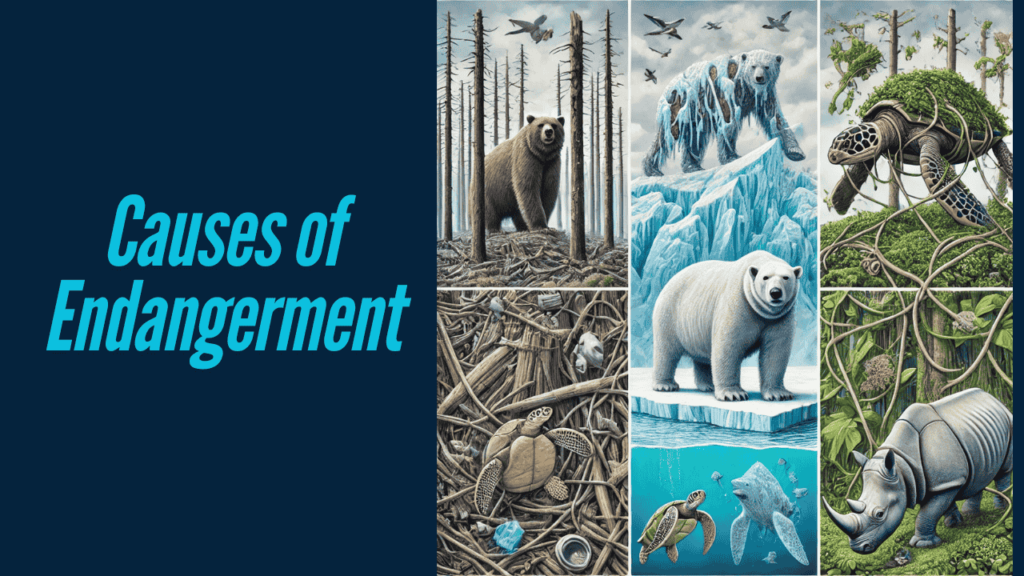
Conservation Methods
Efforts to save endangered species employ a range of strategies, each tailored to specific threats and species requirements.
1. Habitat Protection and Restoration
Protecting critical habitats is foundational to conservation. This includes establishing protected areas, restoring degraded lands, and promoting sustainable land-use practices.
Example: Amazon Rainforest Conservation
Efforts to curb deforestation in the Amazon involve reforestation projects, community engagement, and government policies to reduce illegal logging.
2. Captive Breeding and Reintroduction Programs
Breeding programs in zoos and wildlife reserves aim to increase population numbers of critically endangered species. Successful programs eventually reintroduce these animals into the wild.
Example: California Condor Recovery
From just 27 individuals in 1987, the California condor population has rebounded to over 500 through captive breeding and monitoring efforts.
| Species | Starting Population | Current Population | Key Effort |
|---|---|---|---|
| California Condor | 27 | 500+ | Captive breeding and release |
| Arabian Oryx | Extinct in Wild | 1,000+ | Global breeding initiatives |
| Black-Footed Ferret | 18 | 300+ | Conservation breeding |
3. Legislation and Policy Implementation
Laws and policies are vital in regulating human activities that harm species. International agreements like the Convention on International Trade in Endangered Species (CITES) combat illegal wildlife trade.
Example: The Endangered Species Act (USA)
This landmark legislation provides legal protections to endangered species and their habitats, enforcing penalties for violations.
4. Community Involvement
Engaging local communities ensures sustainable conservation practices. Providing economic incentives through ecotourism or sustainable harvesting helps align conservation goals with local livelihoods.
Example: Mountain Gorilla Conservation
In regions like Rwanda and Uganda, eco-tourism initiatives generate revenue for communities, motivating locals to protect mountain gorillas.
Success Stories in Conservation
1. The Giant Panda
Once classified as endangered, the giant panda’s population increased due to habitat protection, bamboo reforestation, and captive breeding programs. The species is now listed as “Vulnerable.”
2. The Bald Eagle
The use of pesticides like DDT almost wiped out the bald eagle population in the mid-20th century. Conservation measures, including banning DDT and protecting nesting sites, have led to a remarkable recovery.
3. Sea Turtles
Conservation groups have worked globally to protect sea turtle nesting sites, combat poaching, and reduce bycatch in fisheries. These efforts have stabilized several turtle populations.
Challenges in Conservation
Despite notable successes, significant challenges remain:
1. Funding Limitations
Conservation projects often rely on limited financial resources. Long-term sustainability of programs like reforestation or species monitoring can be difficult.
2. Human-Wildlife Conflict
As human populations expand, conflicts arise over resources. Elephants raiding crops or predators attacking livestock can strain relations between humans and wildlife.
3. Climate Change Adaptation
Rapid environmental changes outpace many species’ ability to adapt, requiring more dynamic conservation strategies.
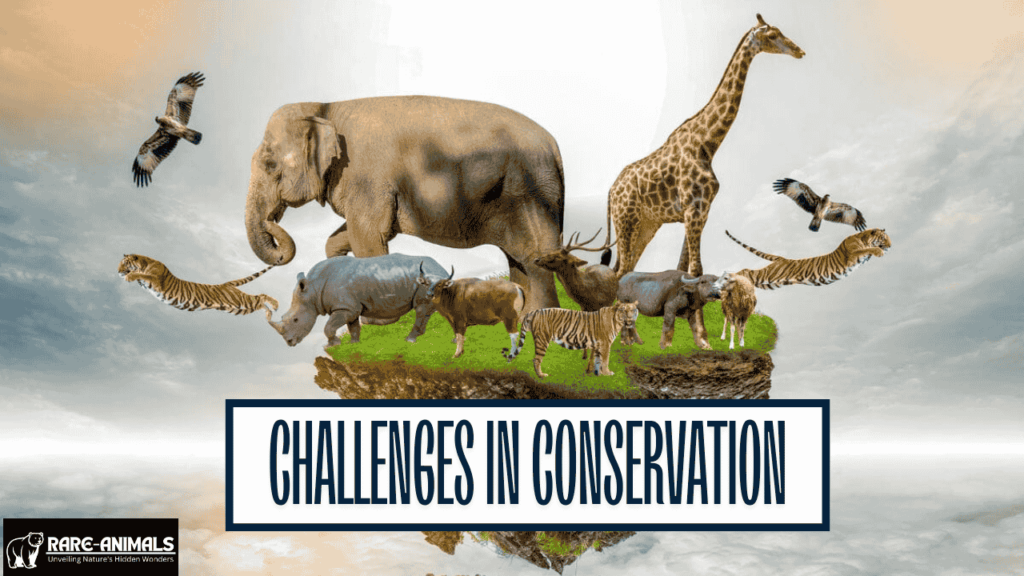
The Role of Technology in Conservation
Advances in technology have revolutionized conservation practices.
1. Satellite Monitoring
Remote sensing technologies track deforestation, habitat changes, and migration patterns, providing critical data for conservation planning.
2. Genetic Research
Genetic studies help identify vulnerabilities in species and promote genetic diversity through targeted breeding programs.
3. Drones and Camera Traps
Drones survey remote areas, while camera traps provide insights into animal behavior without human interference.
| Technology | Application | Example |
|---|---|---|
| Satellite Monitoring | Tracking habitat changes | Amazon deforestation tracking |
| Genetic Analysis | Improving breeding programs | Black-footed ferret genetic study |
| Camera Traps | Observing elusive species | Snow leopard monitoring |
The Future of Conservation
1. Global Collaboration
International cooperation through treaties and shared initiatives is essential to address cross-border challenges.
2. Increased Public Awareness
Educational campaigns and media coverage foster public support for conservation initiatives.
3. Sustainable Development Goals (SDGs)
Integrating conservation with the United Nations SDGs ensures environmental protection aligns with social and economic progress.
Conclusion
Conservation efforts play an indispensable role in halting the loss of biodiversity. From protecting habitats and enforcing legislation to leveraging technology and engaging communities, these efforts demonstrate humanity’s capacity to reverse damage and restore ecosystems. However, continued dedication, innovation, and global cooperation are crucial to securing a future for the world’s endangered species.
Through these concerted actions, we not only save species but also preserve the intricate web of life upon which all humans depend.
FAQs
Q1: What are endangered species?
Endangered species are animals, plants, or organisms at risk of extinction due to factors like habitat destruction, poaching, or climate change.
Q2: Why is conserving endangered species important?
Conserving endangered species helps maintain biodiversity, supports ecosystems, and ensures the survival of essential plants and animals crucial to human survival.
Q3: What are some causes of species endangerment?
Key causes include habitat loss, climate change, pollution, poaching, and competition from invasive species.
Q4: What are some successful conservation efforts?
Success stories include the recovery of the giant panda through habitat protection and the reintroduction of the California condor via captive breeding programs.
Q5: How can individuals contribute to conservation?
Individuals can support conservation by reducing waste, promoting sustainable practices, donating to conservation organizations, and spreading awareness about endangered species.
Q6: What role does technology play in conservation?
Technology aids conservation through satellite monitoring, genetic research, and tools like drones and camera traps to track and protect wildlife.
Q7: How do laws protect endangered species?
Laws like the Endangered Species Act and treaties like CITES regulate human activities that harm species and protect their habitats.
Q8: Are captive breeding programs effective?
Yes, captive breeding programs have successfully increased populations of critically endangered species, often leading to their reintroduction into the wild.
Q9: What challenges do conservation efforts face?
Challenges include funding limitations, human-wildlife conflicts, and the rapid effects of climate change on habitats and species.
Q10: What is the role of local communities in conservation?
Local communities are crucial as they often live near wildlife habitats. By involving them in conservation initiatives, such as eco-tourism or sustainable harvesting, their livelihoods align with protecting species.

Alveena is an experienced content writer with a knack for crafting engaging and insightful pieces. She thrives on breaking down complex ideas and presenting them as clear, captivating content that resonates with readers.

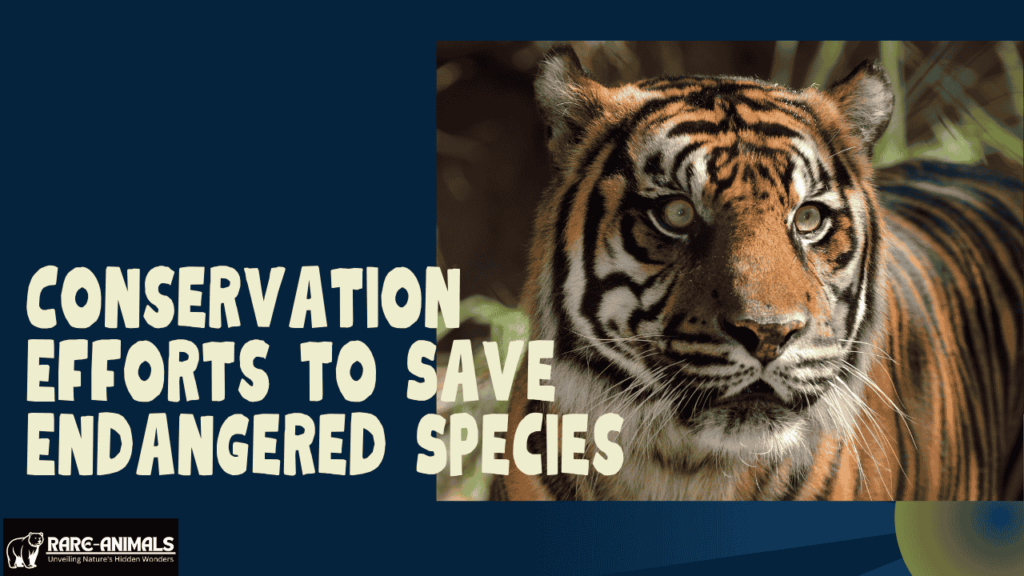

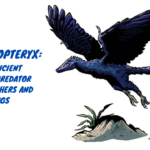

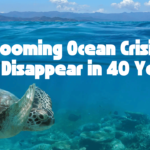
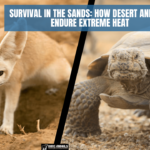

33 thoughts on “Conservation Efforts to Save Endangered Species”